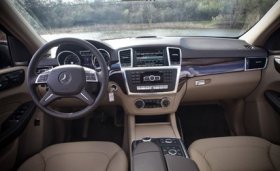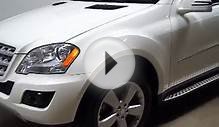
 Now in its third generation, the M-class has gone from the risky startup enterprise of 1997—new vehicle, new workforce, new U.S. assembly plant—to a solidly established luxury SUV with an increasingly firm grip on a market segment it helped to create.
Now in its third generation, the M-class has gone from the risky startup enterprise of 1997—new vehicle, new workforce, new U.S. assembly plant—to a solidly established luxury SUV with an increasingly firm grip on a market segment it helped to create.
There’s also more ML. Compared with its predecessor’s measurements, the 114.8-inch wheelbase is about the same, but overall length increases almost an inch, to 189.1, and width expands 1.5 inches, to 75.8. At 70.7 inches, the roof is closer to mother earth by almost an inch, but then so is the undercarriage—ground clearance for the latest ML350 decreased by almost three inches, to 5.4, which tells you something about the priority of off-road use in the gen-three design. This here is an urban cowboy.
 We logged roughly 1000 miles with our ML350 test vehicles, averaging 19 mpg with the rear-driver and 18 mpg with the 4MATIC. /p table border="0" cellpadding="2" cellspacing="0"x">
We logged roughly 1000 miles with our ML350 test vehicles, averaging 19 mpg with the rear-driver and 18 mpg with the 4MATIC. /p table border="0" cellpadding="2" cellspacing="0"x">
Put that 1-mpg distinction down to the difference in curb weight, which also shows up on the acceleration charts. The rear-drive ML sprinted to 60 mph in 6.4 seconds and ran the quarter-mile in 14.9 at 94 mph. The 4MATIC needed 6.7 seconds to hit 60 and covered 440 yards in 15.1 seconds at 93 mph. We should add that the rolling-acceleration numbers—5-to-60 mph, 30-to-50 mph, etc.—were about the same for both MLs. And we should add further that the 4MATIC’s sprints were significantly quicker than those of the gen-two version—almost a half-second to 60—that contended in our 2007 comparo.
No-Drama Dynamics
The gen-two MLs were all about quiet comfort, and the gen threes are more so. Suspension travel is abundant, and the pneumatic components tuned to make driving down a stairway feel like a cruise through the park. That characteristic is augmented by excellent straight-line stability, and at freeway speeds the interior is as quiet as certain election headquarters were at about 11:13 p.m. EST last November 6.
RELATED VIDEO












